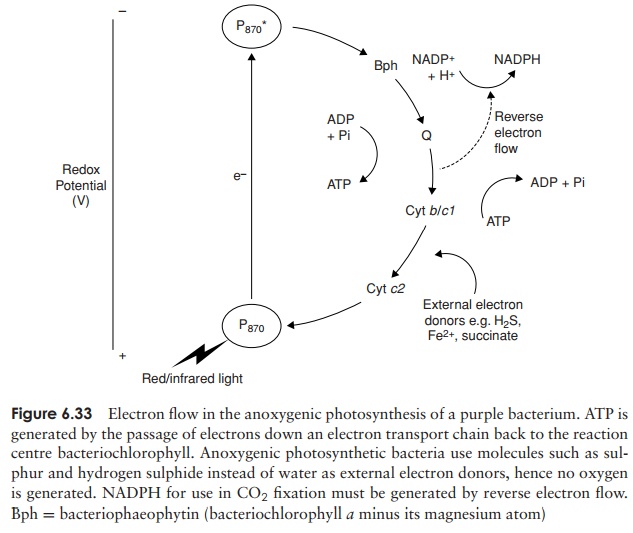Chapter: Essential Microbiology: Microbial Metabolism
Anoxygenic photosynthesis
Anoxygenic
photosynthesis
Photosynthesis as carried out in the purple and green
bacteria is different to the process just described in a number of respects.
Some of the main differences are summarised below:
·
no oxygen is generated during this type of
photosynthesis, and the bacteria involved are growing anaerobically
·
bacteriochlophylls absorb light maximally at longer
wavelengths than chlorophyll a and b, allowing them more effectively to
utilise the light available in their own particular habitat
·
purple and green bacteria are not able to utilise
water as a donor of electrons, and must instead use a compound that is oxidised
more easily, such as hydrogen sulphide or succinate
·
only a single photosystem is involved in the light reactions
of anoxygenic photosynthesis. In the green bacteria this is similar to
photosystem I, while in the purples it more closely resembles photosystem II
·
thylakoid membranes are not found in the green and
purple bacteria; light reactions take place in lamellar invaginations of the
cytoplasmic membrane in the purples and in vesicles called chlorosomes in the greens.

In the generation of ATP, a form of cyclic photophosporylation
is employed; the bac-teriochlorophyll acts as both donor and acceptor of
electrons (Figure 6.33). In order to generate reducing power in the form of
reduced coenzymes, an external electron source is necessary, since this process
is non-cyclic. In the green and purple sulphur bacteria, this role is served by
sulphur or reduced sulphur compounds such as sulphide or thiosulphate. The
non-sulphur bacteria utilise an organic molecule such as succi-nate as an
electron donor. In some cases, the electron donor has a more positive redox
potential than the NADP+ , so in order to reduce the coenzyme, electrons would have to
flow against the electrochemical gradient. An input of energy in the form of
ATP is needed to make this possible, in a process known as reverse electron flow. This also happens in many chemolithotrophs
such as Acidithiobacillus and Nitrobacter. Table 6.4 compares the
different groups of anoxygenic photosynthesisers. A special form of anoxygenic
photosynthesis occurs in the Heliobacteria; these carry out photoheterotrophy
using a unique form of bacteriochlorophyll called bacteriochloro-phyll b. They are unable to use carbon dioxide
as a carbon source.

Related Topics